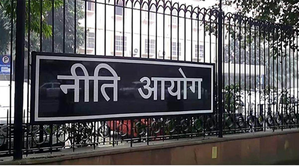New Delhi: Traditionally, poverty has been measured by assessing monetary resources available for an individual or household.
The monetary metric generally used were household income or consumption expenditure. However, this approach of measuring poverty has been criticized for not capturing the multiple deprivations which may be faced by individuals in their lives, says a recent paper by Niti Aayog.
Development not only constitutes economic progress, but also the process of expanding people’s capabilities to convert resources into valuable outcomes. The conventional measures of monetary poverty also suffer from several other limitations like:
1. Income, while necessary, is not a sufficient condition to ensure the overall well-being of individuals, as, income in some cases is spent on items which do not involve the welfare of the household.
2. Due to unavailability of income estimates, monetary poverty measures often rely on consumption expenditure. This may not accurately represent the household’s income, especially when borrowed funds contribute to consumption. In such cases expenditure may surpass or fall short of the actual income depending on borrowing and lending/ saving behavior of household.
3. Household welfare depends not only on its own spending but also on state expenditures for people’s well-being. Monetary poverty measurements overlook the effect of state interventions like subsidized food grains, shelter, sanitation, free education and health, and nutritional support, the NITI Aayog paper said.
Thus, the Multidimensional Poverty Index (MPI) is considered as a more direct and comprehensive measure of people’s deprivation and poverty. MPI captures and reveals the outcome of economic growth and development, income and its distribution and various development initiatives of the State. Besides, it has been globally realised that non-monetary measures complement monetary measures to capture diverse dimensions of poverty.
In its pursuit of addressing the intricacies of poverty, both NITI Aayog and its predecessor, the Planning Commission, have systematically generated poverty estimates over time.
Furthermore, NITI Aayog has been entrusted with the task of formulating an indigenized index for measuring multi dimensional poverty estimates as part of the Global Indices for Reform and Action (GIRG) initiative.
The national MPI adopts the dual-cutoff approach of the AF methodology, consistent with the methodology used in the global MPI report. The national MPI retains all the ten indicators from the global MPI and incorporates two additional indicators, Maternal Health and Bank Accounts, in line with India’s national priorities, the paper said.
India, comprising 36 States and Union Territories, and more than 700 administrative districts, requires a refined policy tool for data-driven decision-making and the formulation of sectoral policies at the sub-national level. In contrast to conventional monetary poverty assessments based on consumption surveys, the national Multidimensional Poverty Index (MPI) delves into deprivations up to the district level, providing a more nuanced perspective.
This granular approach proves essential in India’s diverse context, enabling targeted interventions to address acute poverty and uphold the principle of inclusivity, ensuring that “no one is left behind.” It also offers a method for determining overlapping deprivations in health, education, and standard of living, directly influencing individuals’ quality of life and overall well-being, the paper said.
–IANS


Comments are closed.